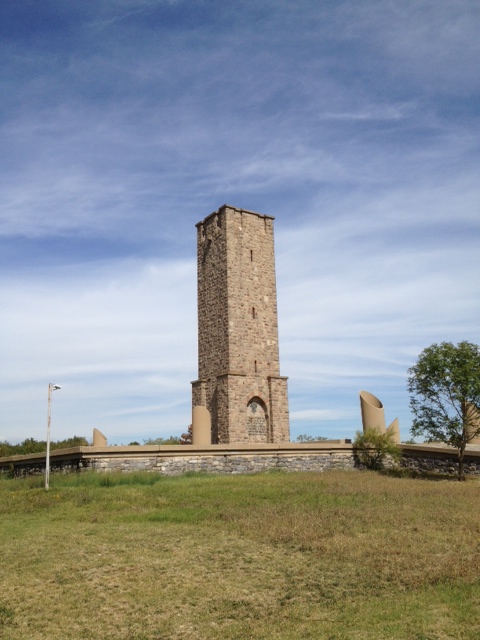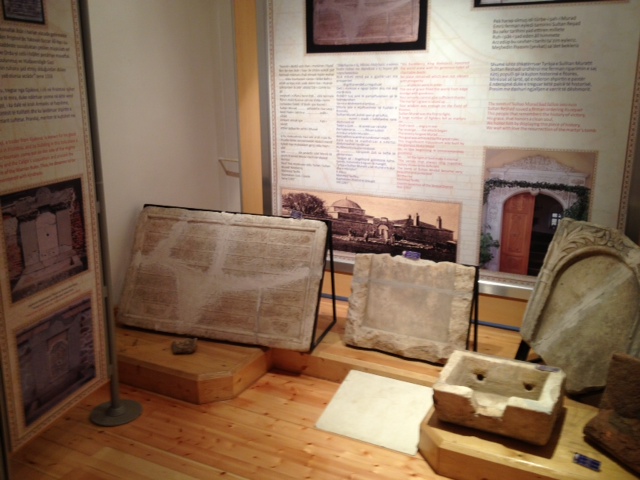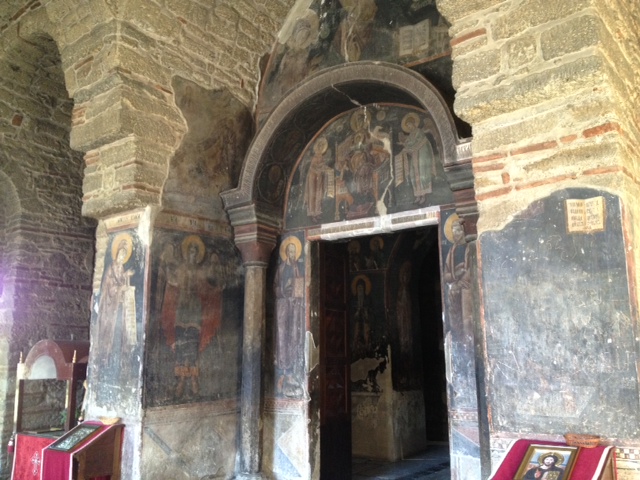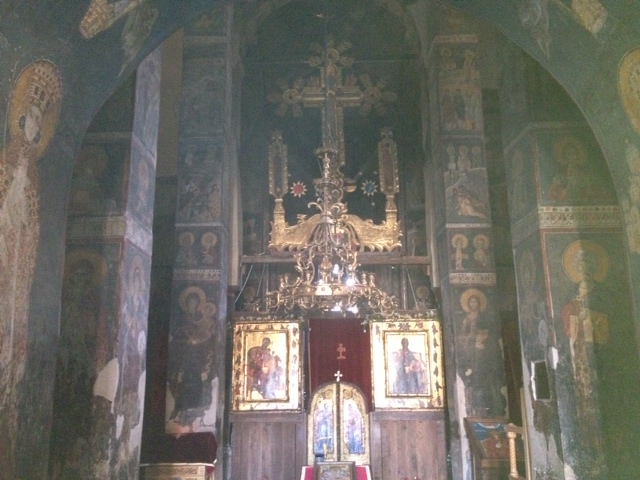.....and while I don't pretend to under the complexities of nationalism and religion in this area, I do know that in many cases, hatreds have built up over centuries and centuries. When I was in Zagreb a few years ago, somebody at the embassy told me a folklore story about the depth of the animosities in the Balkans. As the story goes, God got tired of the endless bickering between the Serbs and Croats so he spoke to one of them and told them, "I will give you any wish you want, but to teach you humility, I will do double for your enemy." Without hesitating, the man told God, "Please put out one of my eyes."
And yet this morning, after another bad night, I went down to the pedestrian mall and sat on a bench in the sun for over an hour and just watched the families strolling by and was thinking to myself how I wished we were that polite and courteous to each other back in the States. But while I was sitting there, a group of Italian KFOR soldiers strolled by taking photos which I guess was a reminder that the people here aren't all that far away from not treating each other with politeness and courtesy.
I am still having stomach issues so I decided against the extended bus trip to Prizren this weekend. Still, it was beautiful outside and I wanted to do something but just didn't want to get too far from the hotel.
After consulting with my guidebook, I decided on another relatively short taxi excursion about ten miles outside of Pristina to a place called Gazimestan, or the memorial complex of the Battle of Kosovo in 1389. Also nearby is the mausoleum of the Sultan Murat's Turbe--who participated in the battle. It was here that the "Curse of Kosovo" was uttered:
As you can see from the photo, the weather was absolutely beautiful. The tanks and soldiers were gone, but today there was a Kosovo policeman at the gate and he did request, and keep, my passport while I was visiting. I believe this place is still a volatile hot spot.
I am cutting and pasting a bit here: "The Gazimestan memorial tower stands in the fields where, in the summer of 1389, the Ottoman Empire clashed with the Serbian medieval kingdom, involving many tens of thousands of troops. Almost every aspect of the Battle of Kosovo is contested. While Serbs mark the clash on June 28, St Vitus Day, most believe it actually took place on June 15. And while Serbs often describe the battle as their empire’s defining defeat at the hands of the Ottomans, it was probably more of a draw. Less contentious is the fact that both Serbian Prince Lazar and Sultan Murat, leader of the Ottomans, died in the battle, along with thousands of others. Both men are thus commemorated at the site. The battle, to this day, plays an essential part in Serbian nationalist narrative, reinforcing the national identity as a bastion against the orient and Islam."
The tower was erected in 1953 on a raised platform that looks much like a castle turret. At the front is the inscription of the Kosovo curse, supposedly written by Prince Lazar, the Serbian leader killed on the battlefield on 1389.....
Translated to English, it reads:
Including the taxi trip to the sultan's mausoleum was almost an afterthought, but turned out to be very interesting.
The building was constructed in the 1850s on the site believed to have been where his tent was pitched during the battle. According to the site, he was attacked and killed by a knife attack during the battle. He is not actually interred here, but his heart and intestines are buried at this site and his exterior body at a mausoleum he had previously constructed in Turkey.
One of the few survivors from the battle is a 700-year-old mulberry tree beside it, ..
Turkey also recently constructed a museum dedicated to the sultan. The young guide I had spoke very good English and seemed very eager to present the material--visiting the mausoleum was a good idea.
And yet this morning, after another bad night, I went down to the pedestrian mall and sat on a bench in the sun for over an hour and just watched the families strolling by and was thinking to myself how I wished we were that polite and courteous to each other back in the States. But while I was sitting there, a group of Italian KFOR soldiers strolled by taking photos which I guess was a reminder that the people here aren't all that far away from not treating each other with politeness and courtesy.
I am still having stomach issues so I decided against the extended bus trip to Prizren this weekend. Still, it was beautiful outside and I wanted to do something but just didn't want to get too far from the hotel.
After consulting with my guidebook, I decided on another relatively short taxi excursion about ten miles outside of Pristina to a place called Gazimestan, or the memorial complex of the Battle of Kosovo in 1389. Also nearby is the mausoleum of the Sultan Murat's Turbe--who participated in the battle. It was here that the "Curse of Kosovo" was uttered:
As you can see from the photo, the weather was absolutely beautiful. The tanks and soldiers were gone, but today there was a Kosovo policeman at the gate and he did request, and keep, my passport while I was visiting. I believe this place is still a volatile hot spot.
I am cutting and pasting a bit here: "The Gazimestan memorial tower stands in the fields where, in the summer of 1389, the Ottoman Empire clashed with the Serbian medieval kingdom, involving many tens of thousands of troops. Almost every aspect of the Battle of Kosovo is contested. While Serbs mark the clash on June 28, St Vitus Day, most believe it actually took place on June 15. And while Serbs often describe the battle as their empire’s defining defeat at the hands of the Ottomans, it was probably more of a draw. Less contentious is the fact that both Serbian Prince Lazar and Sultan Murat, leader of the Ottomans, died in the battle, along with thousands of others. Both men are thus commemorated at the site. The battle, to this day, plays an essential part in Serbian nationalist narrative, reinforcing the national identity as a bastion against the orient and Islam."
The tower was erected in 1953 on a raised platform that looks much like a castle turret. At the front is the inscription of the Kosovo curse, supposedly written by Prince Lazar, the Serbian leader killed on the battlefield on 1389.....
Translated to English, it reads:
Whoever is a Serb and of Serb birth,
And of Serb blood and heritage,
And comes not to fight at Kosovo,
May he never have progeny born from love,
Neither son nor daughter!
May nothing grow that his hand sows,
Neither red wine nor white wheat!
And may he be dying in filth as long as his children are alive!
And comes not to fight at Kosovo,
May he never have progeny born from love,
Neither son nor daughter!
May nothing grow that his hand sows,
Neither red wine nor white wheat!
And may he be dying in filth as long as his children are alive!
Lazar was obviously disappointed at the turnout to support his cause, and as the words describe, his "Curse of Kosovo" was a true Balkan curse.
Several sources I've seen claim Serbia is particularly guilty of historical revisionism and that the folklore surrounding this battlefield is one of the most obvious examples. After the battle, the Ottoman Empire continued across Europe until it reached the Vienna and remained for several centuries. The battle also solidified, in Serbia's eyes at least, it's leadership role in defending and controlling what would become known as the Balkan States. And that perceived role led to modern-day conflicts with Slovenia, Croatia and Kosovo.
Since the Kosovars never really identified with Serbia, fought for independence from Serbia, and are glad to be rid of them, I don't think the curse really affects them. They probably endorse it. Whether historically accurate or not, the date of June 28 has become one of the most important on the calendar:
I understand it is a national holiday in both Kosovo and Serbia, although for different reasons. It was also on this date in 1914 that a Serb nationalist assassinated an Austrian archduke, leading to World War I. On this date in 1921, the Yugoslavia federation was created with Serbia, Croatia and Slovenia--creating the basis for future conflicts in our lifetime. On June 28, 1989, the 600th anniversary of the original battle, Slobodan Milošević--the former president of Serbia--warned of future nationalist battles. He would be involved in Serbian wars against independence movements in the area, including Kosovo, and would die in prison in 2006 during trials in The Hague for war crimes against humanity. That speech, at this location, is credited with the modern breakup of Yugoslavia.
Although the battlefield is not developed as a historical site, the view from the top of the turret gives a nice view of the surrounding area including the mausoleum of the Sultan Murat's Turbe nearby.
Including the taxi trip to the sultan's mausoleum was almost an afterthought, but turned out to be very interesting.
The building was constructed in the 1850s on the site believed to have been where his tent was pitched during the battle. According to the site, he was attacked and killed by a knife attack during the battle. He is not actually interred here, but his heart and intestines are buried at this site and his exterior body at a mausoleum he had previously constructed in Turkey.
One of the few survivors from the battle is a 700-year-old mulberry tree beside it, ..
Turkey also recently constructed a museum dedicated to the sultan. The young guide I had spoke very good English and seemed very eager to present the material--visiting the mausoleum was a good idea.



















































